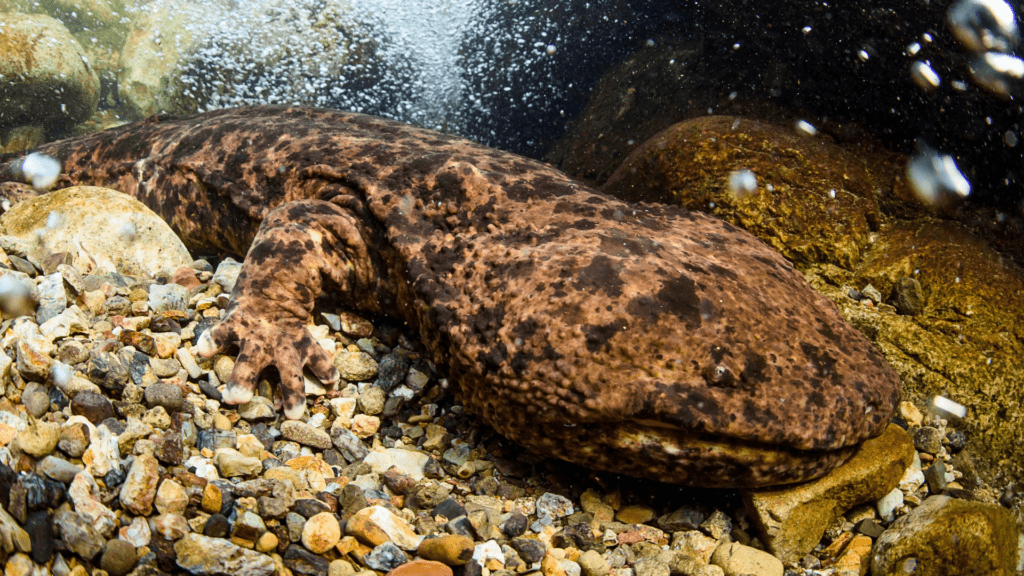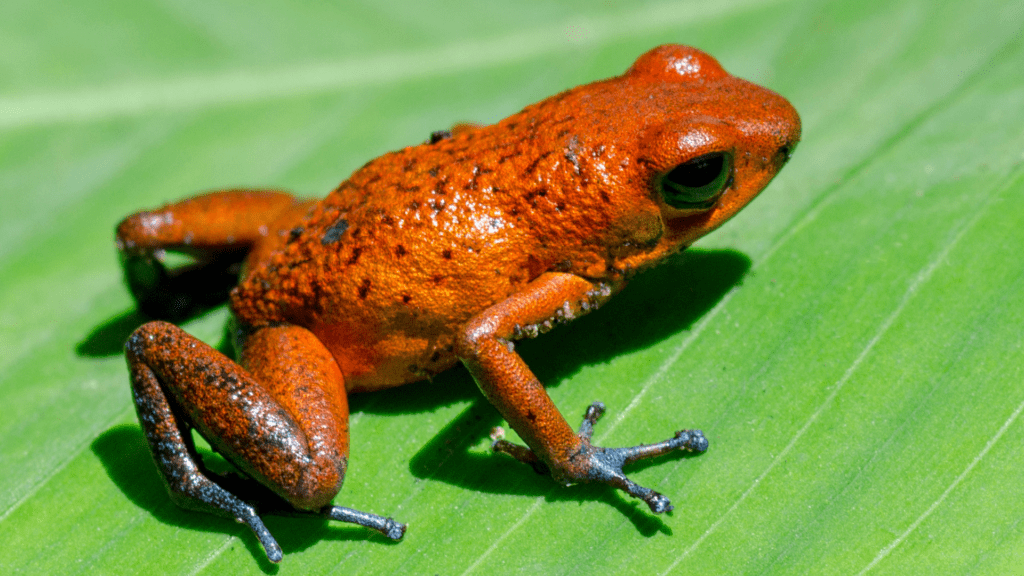Hellbender Salamander (Cryptobranchus alleganiensis) is an extraordinary amphibian, renowned for its size, unique features, and aquatic lifestyle. This species is one of the largest salamanders in North America, and its populations are predominantly found in clean, fast-flowing streams and rivers. Unfortunately, due to environmental pressures, their numbers have been declining, making conservation efforts imperative for their survival.
“The term ‘Hellbender Salamander’ refers to the species as a whole, which includes both subspecies of the Hellbender, namely the Eastern Hellbender and the Ozark Hellbender, that are recognized for their distinct habitats and unique characteristics.”
Taxonomy and Classification
- Kingdom: Animalia
- Phylum: Chordata
- Class: Amphibia
- Order: Urodela
- Family: Cryptobranchidae
- Genus: Cryptobranchus
- Species: Cryptobranchus alleganiensis
Hellbender Salamanders belong to the genus Cryptobranchus and are part of the Cryptobranchidae family. This group of salamanders includes other giant species, such as the Japanese and Chinese giant salamanders. The Hellbender is a member of this family but is distinct due to its native habitat in the rivers and streams of the eastern United States.
Physical Characteristics
Hellbender Salamanders are easily recognizable due to their large size and distinctive features. These amphibians are primarily aquatic, and their bodies are perfectly adapted for their lifestyle.
- Size: Adult Hellbenders typically range in size from 12 to 29 inches (30 to 74 cm). They are considered the largest salamander species in North America.
- Weight: The average weight of a Hellbender is between 3.3 to 5.5 lbs (1.5 to 2.5 kg).
- Coloration: Their color varies from a brownish or grayish tone to darker, mottled patterns, which help them blend into their environment, providing camouflage from predators.
- Body Structure: Hellbenders have flattened, wrinkled bodies, which assist them in navigating swiftly through fast-moving waters. Their skin is slimy and helps retain moisture while submerged.
Habitat and Distribution
Hellbender Salamanders are typically found in cold, fast-moving streams, rivers, and creeks that are rich in oxygen. Their habitat is restricted to the eastern United States, with their range extending from southern New York to northern Georgia, and they are particularly common in areas with rocky streambeds.
Hellbenders prefer areas with large rocks or boulders, which they use as hiding places. These habitats provide shelter and protection from predators while also giving the salamanders a stable environment where they can thrive.
Diet and Feeding Habits
Hellbender Salamanders are carnivores and primarily feed on invertebrates, particularly crayfish. Their diet can also include small fish, insects, and the eggs of other salamanders. Their nocturnal hunting habits involve crawling along the streambed using their strong legs to find food.
Behavior and Lifestyle
These salamanders are solitary creatures, often spending most of their time hiding under rocks or in crevices. They are nocturnal and only become active during the night. Hellbenders are also territorial and will defend their chosen habitat from other salamanders.
Despite their large size, Hellbenders are not aggressive toward humans but do exhibit protective behavior in the presence of other salamanders, especially during the breeding season.
Reproduction and Lifespan
Hellbenders typically breed in the fall. Males construct nests under large rocks where they guard and protect the eggs. Female Hellbenders can lay up to 200 eggs in a single nest, which are fertilized externally by the male.
The larvae hatch after a few weeks, and after several months of development, they mature into juvenile salamanders. Hellbenders can live for up to 30 years in the wild, although many in captivity can exceed 50 years.
Conservation Status
The Hellbender Salamander is classified as “Near Threatened” by the IUCN Red List due to habitat destruction, pollution, and disease. Some populations are listed as endangered, particularly the Ozark Hellbender, which is found in the Ozark region. Conservation programs have been established to restore populations and protect their habitats, including breeding programs and habitat restoration efforts.
Interesting Facts
- Hellbender Salamanders are often confused with mudpuppies, but unlike mudpuppies, Hellbenders do not have external gills.
- Unique Adaptations: Their wrinkled skin allows for better oxygen absorption, and their flat bodies reduce resistance in fast-moving waters.
- Hellbenders play a critical role in their ecosystem, helping to control crayfish populations and maintain healthy aquatic environments.
Conclusion
The Hellbender Salamander is a fascinating and remarkable amphibian that is unfortunately facing a rapid decline due to environmental threats. As one of the largest amphibians in North America, Hellbenders provide vital ecological services in their habitats. Continued conservation efforts are essential to ensure the survival of this unique species and the preservation of the ecosystems they inhabit.
faq’s
1. What is a Hellbender Salamander?
A Hellbender Salamander (Cryptobranchus alleganiensis) is a large, aquatic amphibian native to the eastern and central United States. It is known for its unique appearance, including a flattened body and wrinkled skin.
2. How big do Hellbender Salamanders get?
Hellbender Salamanders can grow up to 29 inches (74 cm) long, with adult individuals typically weighing between 3.3 lbs and 5.5 lbs (1.5 kg and 2.5 kg).
3. Where do Hellbender Salamanders live?
Hellbender Salamanders are found in cold, fast-moving streams with large rocks and boulders. They are primarily found in the eastern and central United States, including parts of New York, Georgia, and Pennsylvania.
4. What do Hellbender Salamanders eat?
Hellbenders are carnivorous and primarily feed on crayfish, small fish, tadpoles, insects, and the eggs of other salamanders. They hunt by using their strong limbs to crawl along streambeds.
5. How long do Hellbender Salamanders live?
In captivity, Hellbender Salamanders can live up to 30 years. However, in the wild, they may live shorter lives due to environmental challenges.
6. Are Hellbender Salamanders endangered?
Yes, Hellbender Salamanders are classified as “Near Threatened” by the IUCN, and some subspecies, like the Ozark hellbender, are considered endangered due to habitat destruction, pollution, and disease.
7. How do Hellbender Salamanders reproduce?
Hellbender Salamanders reproduce through external fertilization. Males create nests under rocks, and females lay eggs that are fertilized externally. The male guards the eggs until they hatch.
8. What is the Hellbender Salamander’s habitat?
Hellbenders prefer cold, fast-flowing streams with plenty of oxygen and large rocks or boulders where they can hide. They avoid slow-moving, muddy waters.
9. Why are Hellbender Salamanders important to the ecosystem?
Hellbenders help maintain the health of aquatic ecosystems by controlling populations of small invertebrates like crayfish. Their presence is also an indicator of a healthy, clean water environment.
10. Can Hellbender Salamanders breathe underwater?
Hellbender Salamanders primarily breathe through their skin, with their extensive folds allowing for oxygen absorption. While they have simple lungs, they rely on skin respiration for most of their oxygen intake.
References
https://stlzoo.org/animals/amphibians/salamanders-newts/eastern-hellbender
https://www.wired.com/2015/02/creature-feature-10-fun-facts-hellbenders/
https://www.nwf.org/Educational-Resources/Wildlife-Guide/Amphibians/Hellbender
https://www.outdooralabama.com/salamanders/hellbender
https://www.frontiersin.org/articles/10.3389/fevo.2018.00205/full

